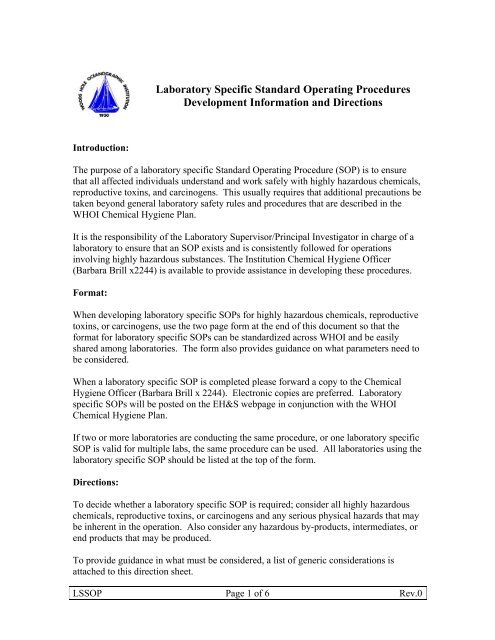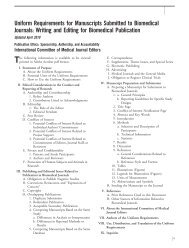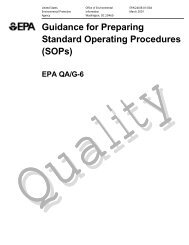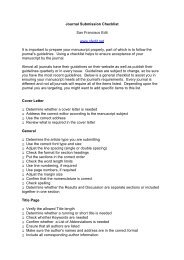Laboratory Specific Standard Operating Procedures (pdf)
Laboratory Specific Standard Operating Procedures (pdf)
Laboratory Specific Standard Operating Procedures (pdf)
Create successful ePaper yourself
Turn your PDF publications into a flip-book with our unique Google optimized e-Paper software.
<strong>Laboratory</strong> <strong>Specific</strong> <strong>Standard</strong> <strong>Operating</strong> <strong>Procedures</strong><br />
Development Information and Directions<br />
Introduction:<br />
The purpose of a laboratory specific <strong>Standard</strong> <strong>Operating</strong> Procedure (SOP) is to ensure<br />
that all affected individuals understand and work safely with highly hazardous chemicals,<br />
reproductive toxins, and carcinogens. This usually requires that additional precautions be<br />
taken beyond general laboratory safety rules and procedures that are described in the<br />
WHOI Chemical Hygiene Plan.<br />
It is the responsibility of the <strong>Laboratory</strong> Supervisor/Principal Investigator in charge of a<br />
laboratory to ensure that an SOP exists and is consistently followed for operations<br />
involving highly hazardous substances. The Institution Chemical Hygiene Officer<br />
(Barbara Brill x2244) is available to provide assistance in developing these procedures.<br />
Format:<br />
When developing laboratory specific SOPs for highly hazardous chemicals, reproductive<br />
toxins, or carcinogens, use the two page form at the end of this document so that the<br />
format for laboratory specific SOPs can be standardized across WHOI and be easily<br />
shared among laboratories. The form also provides guidance on what parameters need to<br />
be considered.<br />
When a laboratory specific SOP is completed please forward a copy to the Chemical<br />
Hygiene Officer (Barbara Brill x 2244). Electronic copies are preferred. <strong>Laboratory</strong><br />
specific SOPs will be posted on the EH&S webpage in conjunction with the WHOI<br />
Chemical Hygiene Plan.<br />
If two or more laboratories are conducting the same procedure, or one laboratory specific<br />
SOP is valid for multiple labs, the same procedure can be used. All laboratories using the<br />
laboratory specific SOP should be listed at the top of the form.<br />
Directions:<br />
To decide whether a laboratory specific SOP is required; consider all highly hazardous<br />
chemicals, reproductive toxins, or carcinogens and any serious physical hazards that may<br />
be inherent in the operation. Also consider any hazardous by-products, intermediates, or<br />
end products that may be produced.<br />
To provide guidance in what must be considered, a list of generic considerations is<br />
attached to this direction sheet.<br />
LSSOP Page 1 of 6 Rev.0
Completing the Form:<br />
General Information:<br />
• List the procedure or hazardous agent covered by the SOP<br />
• Provide the current date in the revision date box<br />
• List the departments or laboratories covered by the SOP. More than one<br />
department or laboratory can be covered by the same procedure if applicable.<br />
• List the Supervisor(s)/Principal Investigator(s) responsible for the laboratory or<br />
laboratories<br />
• The Supervisor(s)/Principal Investigator(s) must sign that they have reviewed and<br />
approved the SOP<br />
• List the names and signatures of the Author(s) of the SOP<br />
• If necessary, the Chemical Hygiene Officer will review and sign SOP<br />
<strong>Specific</strong> Information:<br />
Information required in this section may be collected from labels, Material Safety Data<br />
Sheets (MSDSs), reference resources (see Reference Sources section), or past experience:<br />
• List notifications required prior to conducting the procedure (i.e.,<br />
Supervisor/Principal Investigator or co-workers)<br />
• Describe the hazards or toxicity presented by the chemical<br />
• List exposure symptoms personnel should be aware of and methods they can use<br />
to detect hazardous levels of chemicals<br />
• List engineering or containment devices that must be used (i.e., fume hoods, glove<br />
boxes, biological cabinets, restricted laboratories/laboratory sections, etc.)<br />
• List personal protective equipment that must be used<br />
• List special precautions or conditions (i.e., environmental controls, incompatible<br />
materials, restriction of entry, training, exposure time limits, etc.)<br />
• List emergency response procedures – (i.e., medical response, spill containment<br />
information, fire containment, or shut-off or disconnect requirements)<br />
• List decontamination or waste handling procedures<br />
<strong>Standard</strong> <strong>Operating</strong> Procedure:<br />
Based on the information collected in the previous section, provide a step-by-step<br />
description of the procedure and list precautions and/or safety hazards involved in each<br />
step.<br />
Reference Sources:<br />
• Occupational Safety and Health Administration (OSHA) Regulations and website<br />
• National Institute for Occupational Safety and Health (NIOSH) website<br />
LSSOP Page 2 of 6 Rev.0
• American Conference of Governmental Industrial Hygienists (ACGIH) Threshold<br />
Limit Value (TLV ® ) list and information<br />
• Library Resources – There are a number of Databases available that provide<br />
medical and safety and health information.<br />
• Supplier information/Technical Data<br />
• EH&S Office<br />
• Past experiences with the material or particular operation<br />
Updates:<br />
<strong>Laboratory</strong> specific SOPs should be reviewed on a periodic basis, and updates made<br />
when necessary. Updates should be made when there is any significant change in the<br />
procedure, when new chemical products or equipment are used, when new hazards are<br />
identified, or when safety precautions are determined to be inadequate.<br />
LSSOP Page 3 of 6 Rev.0
Generic <strong>Standard</strong> <strong>Operating</strong> Procedure Considerations - Highly<br />
Hazardous Chemicals, Reproductive Toxins, and Select Carcinogens<br />
Laboratories in which highly hazardous chemicals, reproductive toxins, and select<br />
carcinogens are used must develop specific standard operating procedures (SOPs) for the<br />
safe use of these materials. Listed are some general considerations that may need to be<br />
addressed when completing the SOP form.<br />
• Obtain approval from the Lab Supervisor/Principal Investigator before ordering a<br />
chemical or conducting a procedure<br />
• Order the smallest amount of the chemical required<br />
• Keep compressed gas cylinders containing acutely toxic materials in ventilated<br />
gas cabinets (Contact Facilities for design and construction assistance)<br />
• Ensure that all chemical containers are legibly labeled<br />
• Review the container label and Material Safety Data Sheet of unfamiliar<br />
chemicals<br />
• Isolate the laboratory or laboratory section where a chemical will be used and<br />
restrict the presence of non-essential personnel and traffic<br />
• Post appropriate warning signs (e.g., DANGER; BIOHAZARD, AUTHORIZED<br />
PERSONNEL ONLY, etc.)<br />
• Ensure that required engineering controls are available and in working order<br />
• Wear appropriate street clothing. Prohibit shorts, short skirts, sandals, sneakers,<br />
and open-toed shoes when working with these materials<br />
• Wear a lab coat over street clothes<br />
• Ensure that all required personal protective equipment is available<br />
• Determine disposition of waste and the need to filter or treat any fume hood<br />
discharge before conducting the procedure<br />
• Ensure that all employees have received appropriate safety and health training<br />
including chemical hazard information, lab safety training, first aid, spill<br />
reporting, and use of engineering controls and personal protective equipment.<br />
• Use appropriate engineering controls (e.g. fume hood, biological cabinet, glove<br />
box, etc.)<br />
• Use coverings or trays to protect work surfaces from contamination<br />
• Decontaminate work surfaces and equipment upon completion of procedure or at<br />
regular intervals for a procedure of long duration<br />
• Store highly hazardous chemicals in a safe and secure location<br />
• Dispose of waste materials in a safe manner<br />
LSSOP Page 4 of 6 Rev.0
<strong>Laboratory</strong> <strong>Specific</strong> <strong>Standard</strong> <strong>Operating</strong> Procedure – Highly<br />
Hazardous Chemicals, Reproductive Toxins, and Select Carcinogens<br />
Procedure/Hazardous Agent:<br />
Department(s)/Laboratories<br />
Supervisor(s)/Principal Investigator(s):<br />
Revision Date:<br />
Supervisor(s)/Principal Investigator(s) signature(s):<br />
Authors (names):<br />
Signature(s):<br />
Reviewed by CHO (signature):<br />
Special Notifications:<br />
Hazard Description/Toxicity:<br />
Special Detection Methods:<br />
Engineering Controls:<br />
Personal Protective Equipment:<br />
Special Precautions/Conditions:<br />
Special Emergency <strong>Procedures</strong>:<br />
Decontamination/Waste Disposal:<br />
LSSOP Page 5 of 6 Rev.0
<strong>Laboratory</strong> <strong>Specific</strong> <strong>Standard</strong> <strong>Operating</strong> Procedure: Provide a step-by-step<br />
procedure for the use of the highly hazardous chemical, reproductive toxin, or<br />
carcinogen. Include special provisions such as a designated area, use of engineering<br />
controls or containment devices, personal protective equipment, special warnings,<br />
decontamination procedures, etc. (Additional pages may be used.)<br />
LSSOP Page 6 of 6 Rev.0







